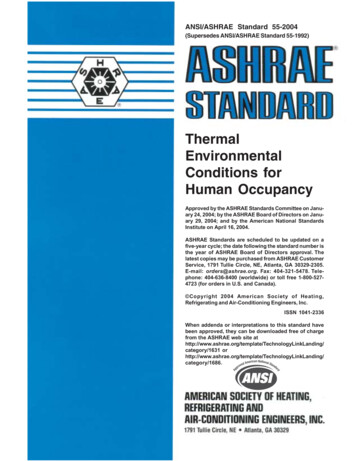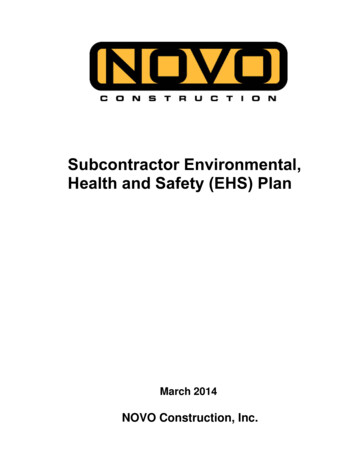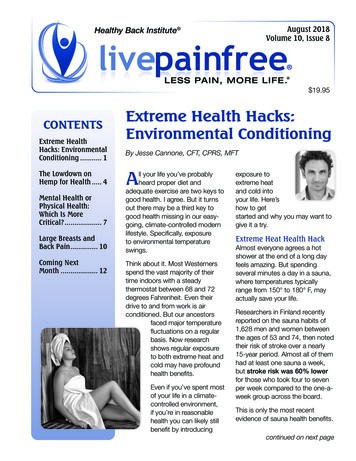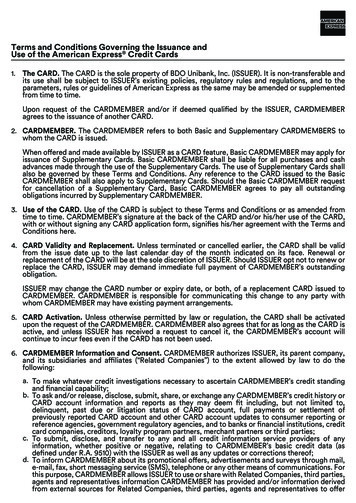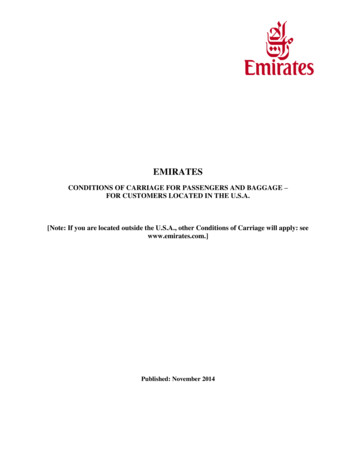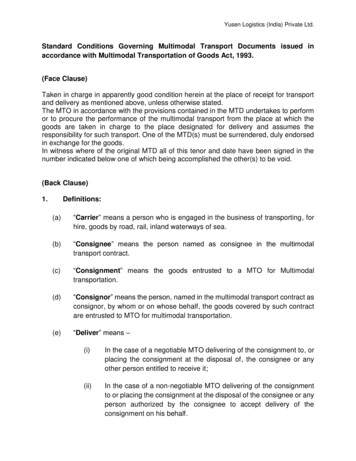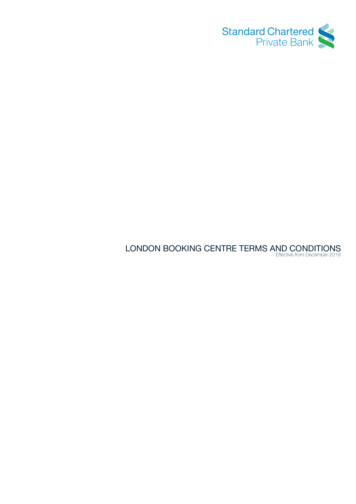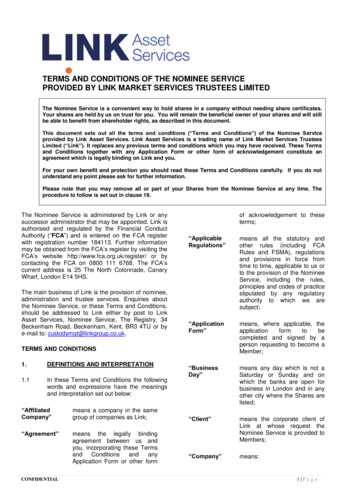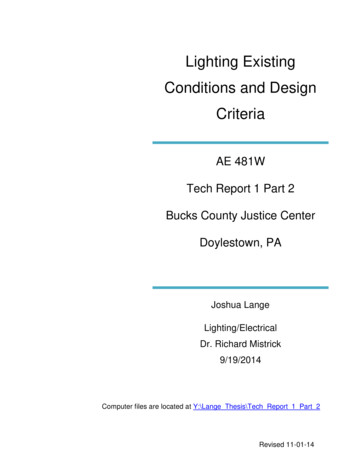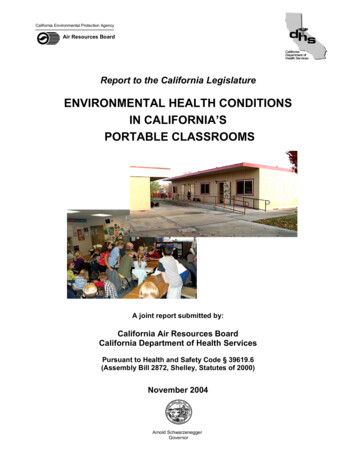
Transcription
California Environmental Protection AgencyAir Resources BoardReport to the California LegislatureENVIRONMENTAL HEALTH CONDITIONSIN CALIFORNIA’SPORTABLE CLASSROOMSA joint report submitted by:California Air Resources BoardCalifornia Department of Health ServicesPursuant to Health and Safety Code § 39619.6(Assembly Bill 2872, Shelley, Statutes of 2000)November 2004Arnold SchwarzeneggerGovernor
ENVIRONMENTAL HEALTH CONDITIONS IN CALIFORNIA’S PORTABLE CLASSROOMSACKNOWLEDGEMENTSWe are particularly grateful to the many school administrators, teachers, and facility managerswho took time from their very busy schedules to respond to detailed questionnaires and to allowentry to their campuses during difficult times following the terrorist attacks of September 11th.Without their cooperation and assistance, this study would not have been possible.We acknowledge the dedication and perseverance of the Research Triangle Institute (RTI) fieldtechnicians and survey specialists who overcame many obstacles: Lewis Cauble, David DeKort,Heather Lesnik, Molly Burton, Rebecca Premock, John Roberts, Jane Serling, Michael Phillips,and Jeremy Morton. We also acknowledge the skill and perseverance of the RTI research staffwho provided the overall study design, obtained and analyzed environmental samples, andanalyzed a very large and complex data set: Gerry Akland (Principal Investigator), RoyWhitmore (Co-principal Investigator), Andy Clayton, James Blake, Marlene Clifton, Linda Ellis,Reshan Fernando, Tricia Webber, Karin Foarde, Larry Michael, Doris Smith, and AnnetteGreen.We appreciate the valuable input received from the following groups: California Portable Classrooms Study Dust Analysis Panel, who provided helpfulsuggestions concerning the analyses of the floor dust samples: Martha Harnly and JanetMacher (Department of Health Services), Myrto Petreas (Department of Toxic SubstanceControl), and Randy Segawa (Department of Pesticide Regulation). Many government agency representatives who provided thoughtful comments on the studydesign and draft reports, especially Duwayne Brooks and Tony Hesch, Department ofEducation; Richard Lam, Bob Blaisdell, and Jim Carlisle, Office of Environmental HealthHazard Assessment; Deborah Gold and Bob Nakamura, Cal/OSHA; Kathy Frevert andDana Papke, Integrated Waste Management Board; Sandra McNeel, Department of HealthServices; Carol Shellenberger and Rich Sheffield, Office of Public School Construction;Panama Bartholomy and Richard Conrad, Division of the State Architect; Shelly Rosenblumand Barbara Spark, U.S. Environmental Protection Agency, Region 9; and many others. Many staff from many schools and districts, who provided information prior to the study,assisted with pre-tests and the pilot study, and provided input on the results andrecommendations of the study, and a special thanks to the Los Angeles Unified SchoolDistrict (LAUSD), and especially Jay Brakensiek, for information, checklists, and photos fromLAUSD’s Facility Inspection Program. Stakeholders from the public and private sectors, who attended the public workshops andshared their experiences and suggestions concerning indoor environmental quality inclassrooms. Researchers who shared their experience and results from related studies: Richard Corsiand Vince Torres (University of Texas, Austin); Mike Lubliner, Rich Prill, and Mike McSorley(Washington State University); Michael Brauer and Karen Bartlett (University of BritishColumbia); Lisa Heschong (Heschong-Mahone Group); and Derek Shendell (University ofCalifornia Los Angeles). Manufacturers and their representatives who shared information on their processes,products, and concerns, especially Scott Alexander, Mobile Modular ManagementCorporation; Maury Tiernan, Geary Pacific; the School Facilities Manufacturers’ Association;and Joe Sublett, Enviroplex, who provided a special tour of his facility at the start of thestudy.i
ENVIRONMENTAL HEALTH CONDITIONS IN CALIFORNIA’S PORTABLE CLASSROOMS Susan Lum, ARB website management and data file review; Helena Lee, ARB studentassistant, for researching noise and lighting standards and guidelines; and JacquelineCummins, ARB, for secretarial support.Finally, we honor our colleague and study group member, Dr. Kai-Shen Liu, of the CaliforniaDepartment of Health Services, who died suddenly during this project. Dr. Liu played a key rolein the early development of the study design and in the Phase I statistical analyses. He iswarmly remembered and missed by all.ii
ENVIRONMENTAL HEALTH CONDITIONS IN CALIFORNIA’S PORTABLE CLASSROOMSDISCLAIMERThe mention of commercial products, their source, or their use in connection withmaterial presented in this report is not to be construed as actual or implied endorsementof such products by the State of California.ALTERNATIVE FORMS OF REPORTIf you are a person with a disability and desire to obtain this document in an alternativeformat, please contact Jacqueline Cummins at (916) 445-0753 orjcummins@arb.ca.gov. TTY/TDD/Speech-to-speech users may dial 7-1-1 for theCalifornia Relay Service.This report also is available electronically on ARB’s website tmiii
ENVIRONMENTAL HEALTH CONDITIONS IN CALIFORNIA’S PORTABLE CLASSROOMSS T A T E OF C A L I F O R N I AARNOLD SCHWARZENEGGERGovernorTERRY TAMMINENAgency SecretaryCalifornia EnvironmentalProtection AgencyS. KIMBERLY BELSHÉAgency SecretaryCalifornia Health and Human ServicesAgencyCALIFORNIA AIR RESOURCES BOARDALAN C. LLOYD, Ph.D., ChairmanSANDRA BERGDORENE D’ADAMOMARK J. DeSAULNIERHENRY GONG, Jr., M.D.LYDIA H. KENNARDRONALD O. LOVERIDGEBARBARA PATRICKPATRICIA SALAS PINEDABARBARA RIORDANRON ROBERTSCATHERINE WITHERSPOON, Executive OfficerCALIFORNIA DEPARTMENT OF HEALTH SERVICESSANDRA SHEWRY, Directoriv
ENVIRONMENTAL HEALTH CONDITIONS IN CALIFORNIA’S PORTABLE CLASSROOMSAUTHORSPrincipal AuthorsPeggy L. Jenkins, M.S., ManagerIndoor Exposure Assessment Section, ARBThomas J. Phillips, M.S.Staff Air Pollution Specialist, ARBJed Waldman, Ph.D., ChiefIndoor Air Quality Program, DHSStaff ContributorsWhitney Webber, ARBKai-Shen Liu, M.P.H., Ph.D., DHSJanet Macher, M.P.H., Sc.D., DHSFeng C. Tsai, Ph.D., DHSReport ReviewersRichard Bode, Chief, Health and Exposure Assessment Branch, ARBBart Croes, P.E., Chief, Research Division, ARBMichael Scheible, Deputy Executive Officer, ARBLeon Alevantis, M.S., P.E., Deputy Chief, Indoor Air Quality Section, DHSC. Peter Flessel, Ph.D., Chief, Environmental Health Laboratory Branch, DHSRaymond Richard Neutra, M.D., Dr.P.H., Chief, Environmental & Occupational DiseaseControl Division, DHSv
ENVIRONMENTAL HEALTH CONDITIONS IN CALIFORNIA’S PORTABLE CLASSROOMSTABLE OF CONTENTSDISCLAIMER .iiiACRONYMS . viiiABBREVIATIONS AND SYMBOLS. xGLOSSARY OF TERMS .xiEXECUTIVE SUMMARY. 11. INTRODUCTION. 241.1 Mandate and Need for the Study. 241.2 Definition of Portable Classrooms . 251.3 Purpose and Scope of the Study. 251.4 Stakeholder Participation. 262. BACKGROUND. 282.1 Indoor Environmental Conditions and Potential Health Effects . 282.2 Potential Economic and Performance Impacts. 292.3 Indoor Environmental Regulations and Guidelines for Public Schools . 302.3.1 Environmental Contaminants . 312.3.2 Ventilation and Comfort . 322.3.3 Noise and Lighting. 322.3.4 Mold. 332.4 Design and Construction of Portable Classrooms . 352.4.1 State Relocatable Classroom Program . 362.4.2 California Collaborative for High Performance Schools. 372.4.3 U.S. EPA IAQ Design Tools for Schools . 382.4.4 State Workgroup on Relocatable Classrooms. 382.4.5 Innovative Design Initiatives . 382.4.6 Portable Classroom Manufacturers . 392.4.7 LAO Blueprint for School Facility Finance . 392.5 School Operation and Maintenance (O&M) Practices . 402.5.1 LAUSD’s Facility Inspection Program. 402.5.2 U.S. EPA’s IAQ Tools For Schools Program . 412.5.3 Lead-Safe Schools . 422.5.4 Integrated Pest Management (IPM) . 432.5.5 School-based Asthma Management Program. 432.5.6 Statewide Organizations. 443. STUDY METHODS AND RESULTS . 453.1 Methods. 453.1.1 Phase I . 463.1.2 Phase II . 463.2 Results . 483.2.1 Classroom and School Characteristics. 483.2.2 Building Materials and Other Pollutant Sources . 483.2.3 Environmental Problems . 493.2.4 Building Operation and Maintenance . 493.2.5 Classroom Ventilation. 503.2.6 Air Pollutant Measurements . 53vi
ENVIRONMENTAL HEALTH CONDITIONS IN CALIFORNIA’S PORTABLE CLASSROOMS3.2.7 Floor Dust Contaminants. 593.2.8 Moisture and Mold. 643.2.9 Pollen . 673.2.10 Noise . 683.2.11 Lighting. 683.2.12 Specially Selected Classrooms . 693.3 Summary of Results . 694. RELATED STUDIES IN CALIFORNIA SCHOOLS. 715. INFORMATION FROM OTHER STATES . 756. SUMMARY OF STAKEHOLDER INPUT. 766.1 Pre-Study Workshops . 766.2 Post-Study Workshops . 777. RECOMMENDATIONS AND DISCUSSION . 788. SUMMARY AND CONCLUSIONS . 848.1 Results . 848.2 Recommendations . 868.3 Conclusions. 87REFERENCES. 89APPENDIX I : Health and Safety Code Section 39619.6. . .I-1APPENDIX II : DHS Pre-Survey . .II-1APPENDIX III : RTI/ARB-DHS Project Executive Summary . . .III-1APPENDIX IV : Recommendations to Schools for Reducing Formaldehyde. .IV-1APPENDIX V : LAUSD Checklist . .V-1APPENDIX VI: Working Draft Suggestions for Preventive and Remedial Actions. .VI-1LIST OF TABLESTable 2-1. Selected Guidelines and Standards Relevant to School Environments. . 34Table 3-1. Study Design, Phases I and II. . 45Table 3-2. Phase II, Summary of Environmental Measurements. . 47Table 3-3. Percent of classrooms with certain building characteristics, Phase I. . 48Table 3-4. Percent of classrooms with environmental problems reported by teachers,Phase I. . 49Table 3-5. HVAC Maintenance Characteristics, Phase II. . 50Table 3-6. HVAC Operation Characteristics, Phase II. 52Table 3-7. Indoor Formaldehyde Concentrations, Phase I and II. . 54Table 3-8. Percent of Classrooms with Moisture Indicators, Phase II. . 65Table 3-9. National Concentration Guidelines for Outdoor Airborne Mold Spores andPlant Pollen* . 67Table 3-10. Classroom Noise and Lighting Conditions Exceeding Standards. 68Table 3-11. Summary of Contaminant Levels in Air and Floor Dust, Phase II. 70vii
ENVIRONMENTAL HEALTH CONDITIONS IN CALIFORNIA’S PORTABLE AHERAALAANSIARBASHRAEAmerican Academy of Allergy Asthma and ImmunologyAmbient Air Quality StandardsAssembly BillAssociation of California School AdministratorsAsbestos Hazard Emergency Response ActAmerican Lung AssociationAmerican National Standards InstituteCalifornia Air Resources BoardAmerican Society of Heating, Refrigerating, and Airconditioning EngineersCalifornia Asthma Among the School-AgedCalifornia Environmental Protection AgencyCalifornia Department of Industrial Relations, Division ofOccupational Safety and HealthCalifornia Association of School Business OfficersCoalition for Adequate School HousingCalifornia Code of RegulationsU.S. Center for Disease ControlCalifornia Department of EducationCalifornia Department of Food and AgricultureCalifornia Energy CommissionCalifornia Collaborative for High Performance SchoolsCalifornia Integrated Waste Management BoardChildhood Lead Poisoning Prevention ProgramCalifornia Department of General ServicesCalifornia Department of Health ServicesU. S. Department of EnergyCalifornia Department of Pesticide RegulationDivision of the State Architect, California Department of GeneralServicesU.S. Environmental Protection AgencyU.S. General Accounting OfficeHigh efficiency particulate arrestanceCalifornia Health and Safety CodeHeating, ventilating, and air conditioningIndoor air qualityIndirect-direct evaporative coolingIndoor environmental qualityIlluminating Engineering Society of North AmericaIntegrated Pest ManagementInterim (Indoor) Reference Exposure LevelCalifornia Legislative Analyst’s IDECIEQIESNAIPMIRELLAOviii
ENVIRONMENTAL HEALTH CONDITIONS IN CALIFORNIA’S PORTABLE APAHPBOPCSPELPMPRGRELRHRTISBSBSSCESFMAUCUCLAU.S. EPAVOCWHOLos Angeles Unified School DistrictLeadership in Energy and Environmental DesignLawrence Berkeley National LaboratoryNational Ambient Air Quality StandardsNational Institute for Occupational Safety and HealthOperation and MaintenanceCalifornia Office of Environmental Health Hazard AssessmentOffice of Public School Construction, California Department ofGeneral ServicesU.S. Occupational Safety and Health AdministrationPolycyclic aromatic hydrocarbonPiperonyl butoxidePortable Classrooms StudyPermissible Exposure LimitParticulate matterPreliminary Remediation GuidelinesReference Exposure LimitRelative HumidityResearch Triangle InstituteSenate BillSick Building SyndromeSouthern California EdisonSchool Facilities Manufacturers AssociationUniversity of CaliforniaUniversity of California, Los AngelesUnited States Environmental Protection AgencyVolatile Organic Compound, Volatile Organic ChemicalWorld Health Organizationix
ENVIRONMENTAL HEALTH CONDITIONS IN CALIFORNIA’S PORTABLE CLASSROOMSABBREVIATIONS AND SYMBOLSTERMDEFINITIONodegrees Celsiuscubic feet per minutecolony forming unitsquare centimetercarbon monoxidecarbon dioxidedecibel (referenced to 1 ampere)degrees Fahrenheitkilogram (one thousand grams)liters per minute (flow rate)square metercubic metermicrogram (one-millionth of a gram)micrograms per gram (concentration)micrograms per square centimeter (surface area)micrograms per cubic meter (concentration)milligrams (one-thousandth of a gram)milligrams per kilogram (concentration)milliliter (one-millionth of a liter)nanogram (one-billionth of a gram)nanograms per gram (concentration)numberpercentpicoCurie per literParticulate matter with aerodynamic diameter less than 2.5 micronsParticulate matter with aerodynamic diameter less than 10 micronsparts per billion (such as one grain of sand in a billion grains ofsand)parts per million (such as one grain of sand in a million grains /lPM2.5PM10ppbppm§Tx
ENVIRONMENTAL HEALTH CONDITIONS IN CALIFORNIA’S PORTABLE CLASSROOMSGLOSSARY OF TERMSTERMDEFINITIONActive/Passive SamplingActive sampling depends on a mechanical process likepumping to collect the sample at a known rate; this was usedfor VOC and aldehyde sample collection. Passive samplinginvolves non-mechanical processes, usually diffusion, inwhich the air is sampled at whatever rate it passes across abadge surface or tube opening. Passive tube samplers wereused in Phase I for the formaldehyde sample collection.Air Changes per HourACH, the volume of air moved in one hour. One air changeper hour in a room, home, or building means that theequivalent of the volume of air in that space will be replacedin one hour.Air Flow RateThe rate at which air moves into a space. Expressed i
HVAC Heating, ventilating, and air conditioning . IAQ Indoor air quality . IDEC Indirect-direct evaporative cooling . IEQ Indoor environmental quality . IESNA Illuminating Engineering Society of North America . IPM Integrated Pest Management . IREL Interim (Indoor) Reference Exposure L
